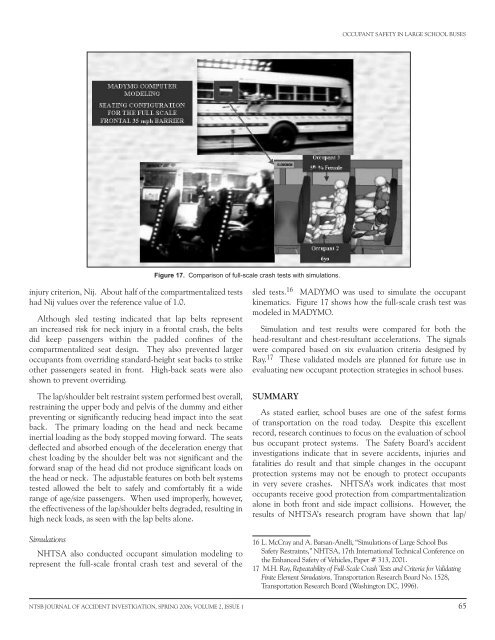Journal of Accident Investigation
Journal of Accident Investigation
Journal of Accident Investigation
You also want an ePaper? Increase the reach of your titles
YUMPU automatically turns print PDFs into web optimized ePapers that Google loves.
injury criterion, Nij. About half <strong>of</strong> the compartmentalized tests<br />
had Nij values over the reference value <strong>of</strong> 1.0.<br />
Although sled testing indicated that lap belts represent<br />
an increased risk for neck injury in a frontal crash, the belts<br />
did keep passengers within the padded confines <strong>of</strong> the<br />
compartmentalized seat design. They also prevented larger<br />
occupants from overriding standard-height seat backs to strike<br />
other passengers seated in front. High-back seats were also<br />
shown to prevent overriding.<br />
The lap/shoulder belt restraint system performed best overall,<br />
restraining the upper body and pelvis <strong>of</strong> the dummy and either<br />
preventing or significantly reducing head impact into the seat<br />
back. The primary loading on the head and neck became<br />
inertial loading as the body stopped moving forward. The seats<br />
deflected and absorbed enough <strong>of</strong> the deceleration energy that<br />
chest loading by the shoulder belt was not significant and the<br />
forward snap <strong>of</strong> the head did not produce significant loads on<br />
the head or neck. The adjustable features on both belt systems<br />
tested allowed the belt to safely and comfortably fit a wide<br />
range <strong>of</strong> age/size passengers. When used improperly, however,<br />
the effectiveness <strong>of</strong> the lap/shoulder belts degraded, resulting in<br />
high neck loads, as seen with the lap belts alone.<br />
Simulations<br />
NHTSA also conducted occupant simulation modeling to<br />
represent the full-scale frontal crash test and several <strong>of</strong> the<br />
Figure 17. Comparison <strong>of</strong> full-scale crash tests with simulations.<br />
OCCUPANT SAFETY IN LARGE SCHOOL BUSES<br />
sled tests. 16 MADYMO was used to simulate the occupant<br />
kinematics. Figure 17 shows how the full-scale crash test was<br />
modeled in MADYMO.<br />
Simulation and test results were compared for both the<br />
head-resultant and chest-resultant accelerations. The signals<br />
were compared based on six evaluation criteria designed by<br />
Ray. 17 These validated models are planned for future use in<br />
evaluating new occupant protection strategies in school buses.<br />
SUMMARY<br />
As stated earlier, school buses are one <strong>of</strong> the safest forms<br />
<strong>of</strong> transportation on the road today. Despite this excellent<br />
record, research continues to focus on the evaluation <strong>of</strong> school<br />
bus occupant protect systems. The Safety Board’s accident<br />
investigations indicate that in severe accidents, injuries and<br />
fatalities do result and that simple changes in the occupant<br />
protection systems may not be enough to protect occupants<br />
in very severe crashes. NHTSA’s work indicates that most<br />
occupants receive good protection from compartmentalization<br />
alone in both front and side impact collisions. However, the<br />
results <strong>of</strong> NHTSA’s research program have shown that lap/<br />
16 L. McCray and A. Barsan-Anelli, “Simulations <strong>of</strong> Large School Bus<br />
Safety Restraints,” NHTSA, 17th International Technical Conference on<br />
the Enhanced Safety <strong>of</strong> Vehicles, Paper # 313, 2001.<br />
17 M.H. Ray, Repeatability <strong>of</strong> Full-Scale Crash Tests and Criteria for Validating<br />
Finite Element Simulations, Transportation Research Board No. 1 28,<br />
Transportation Research Board (Washington DC, 1996).<br />
NTSB JOURNAL OF ACCIDENT INVESTIGATION, SPRING 2006; VOLUME 2, ISSUE 1 6
















